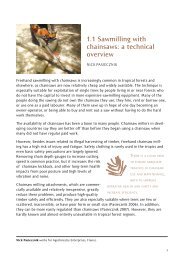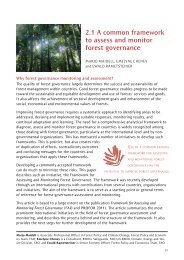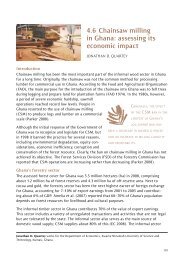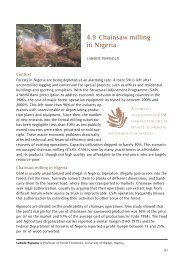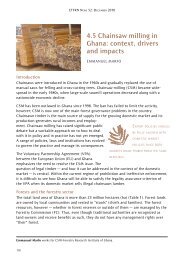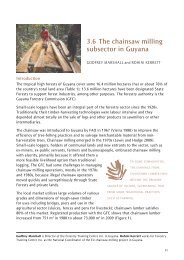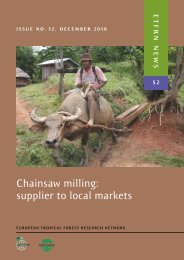Chainsaw milling: supplier to local markets - European Tropical ...
Chainsaw milling: supplier to local markets - European Tropical ...
Chainsaw milling: supplier to local markets - European Tropical ...
Create successful ePaper yourself
Turn your PDF publications into a flip-book with our unique Google optimized e-Paper software.
4.5 chaiNsaw milliNg iN ghaNa: coNTExT, DRivERs aND impacTs<br />
Ghana used <strong>to</strong> be rich in forest resources, and forests were an important part of the<br />
economy. There is a large <strong>local</strong> timber sec<strong>to</strong>r, which is predominantly export-oriented and<br />
unable <strong>to</strong> fulfill the demands of the less lucrative domestic <strong>markets</strong>. Today, the country‘s<br />
forest resources are highly degraded. wildfires, agriculture and indiscriminate logging<br />
(including through Csm) have contributed <strong>to</strong> this problem.<br />
Table 1. key facts about forestry in Ghana<br />
land area 238,500 km 2<br />
population 22.5 million<br />
estimated number employed by forest industry 100,000<br />
forest area (forest reserves) 1.6 million ha (16,000 km 2 )<br />
off-reserve forest area 400,000 ha (4,000 km 2 ) over an area<br />
of 6 million ha<br />
annual allowable Cut (aaC) 2 million m 3 per annum<br />
(1.5 million in off-reserve forests; 0.5<br />
million m 3 in forest reserves)<br />
installed processing capacity 5 million m 3 per annum<br />
deforestation rate 65,000 ha/year<br />
export value wood products GhC 366 million (us$260 million)<br />
contribution <strong>to</strong> GDp 6%<br />
institutional and legal framework<br />
<strong>Chainsaw</strong> <strong>milling</strong> was a recognized enterprise before the 1980s, after which registration<br />
by District assemblies became required. in 1991, direct controls were instituted; logging<br />
procedures and post-logging inspection measures were tightened. Csm continued in an<br />
excessive and uncontrollable way, and in 1998 the practice — including transportation<br />
and trade of its products — was completely prohibited by law. This ban has not ended the<br />
practice, however, and Csm continues <strong>to</strong> dominate supply <strong>to</strong> the domestic market.<br />
Csm is mainly regulated through the Timber Resource Management Act and its legislative<br />
instruments. The Timber resources management regulations of 1998 have specific<br />
provisions that criminalize chainsaw <strong>milling</strong> and operations for commercial purposes.<br />
if the lumber is not meant for sale, exchange or for any commercial purpose, then Csm is<br />
permitted. The source of the timber — whether from forest reserves, farms within forest<br />
reserves or community forests — is not relevant. although the law seems <strong>to</strong> allow Csm<br />
with a registered chainsaw for household purposes, it does not allow this lumber <strong>to</strong> be<br />
transported unless accompanied by a conveyance certificate. To address this contradiction,<br />
some District managers of the Forestry services have issued waybills <strong>to</strong> allow the<br />
transport of Csm lumber.<br />
151



